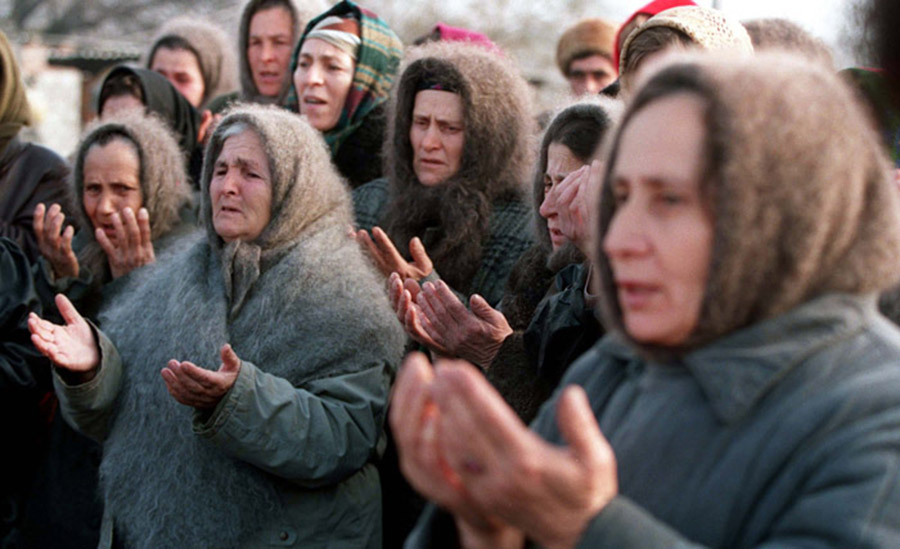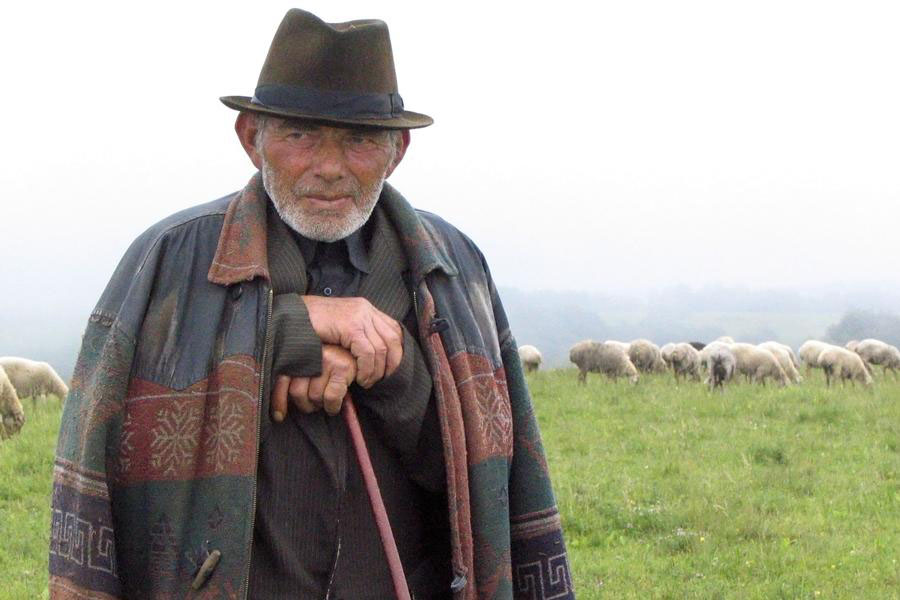Affinity Blocs: March-April 2013 Highlights
Eurasian Peoples and East Asian Peoples

Spotlight for March 2013
Eurasian Peoples
With Emphasis on the Peoples of the North Caucasus
By Helen Bruce
 “Russia is for Russians.” In 2013 Moscow this prolific and profane graffiti hearkens back 100 years to the failed policies of tsars and leaders of Russian Orthodoxy, who advocated for one religion, one administration, one national consciousness. Yet the North Caucasus’ 45 distinct Sunni Muslim ethno-linguistic groups are reminders that not all souls in Russia are Russian! After hundreds of years of battles for Soul and Soil, the Caucasus nations today remain in a “graceless chasm.” Hence the Caucasus proverb: “When will the blood cease to flow in the Caucasus Mountains? When the sugar canes grow in the snow.”
“Russia is for Russians.” In 2013 Moscow this prolific and profane graffiti hearkens back 100 years to the failed policies of tsars and leaders of Russian Orthodoxy, who advocated for one religion, one administration, one national consciousness. Yet the North Caucasus’ 45 distinct Sunni Muslim ethno-linguistic groups are reminders that not all souls in Russia are Russian! After hundreds of years of battles for Soul and Soil, the Caucasus nations today remain in a “graceless chasm.” Hence the Caucasus proverb: “When will the blood cease to flow in the Caucasus Mountains? When the sugar canes grow in the snow.”
During the 1890s-1920s, with a newly completed vernacular Russian Bible, the evangelical church flourished “next door” to Caucasus nations, but the “all nations” mandate of Scripture lost out to nationalistic theologies. Today the blossoming church of the former Soviet Union is overcoming the “-isms” of the past, awakening to God’s heart to send messengers of God’s grace who can communicate a Caucasus Jesus to Caucasus Souls on Caucasus Soil.
Today praying groups have Taken-Into-Their-Hearts (persistently and long-term) 31 of the 34 unreached peoples of Dagestan and the 11 unreached peoples between Chechnya and Adygheya. Thirteen of 45 language groups are legitimately engaged with various phases of intentional, cross-cultural efforts toward disciple-making movements. Fruit comes from “work produced by faith, labor prompted by love, and endurance inspired by hope in our Lord Jesus Christ” (1Thess. 1:3). Still, 32 unreached peoples in Dagestan, Chechnya and Ingushetia remain painfully isolated from God’s blessings of Messengers, the Message and Communities. But we know that God responds to persistent, praying people!

Take-Into-Your-Heart Prayer prays with heart commitment like Paul in Philippians 1:7, that is, 1) praying for presence—the right people, in the right places, at the right times; and 2) praying for completed Scriptures and effective Scripture use. In 2012 the Chechen Bible became the first Caucasus-language Bible completed and published (a 40-year project)! Despite war, active Islamic insurgencies and visa challenges, an increasing number of people are finding jobs or starting micro-businesses with kingdom purposes in view. The North Caucasus Regional Partnership sponsors in-country gatherings for workers to mentor one another, receive training, pray for one another and deal with disciple-making questions. A new generation of workers have developed relational priorities to help each other along—they are brothers and sisters dwelling in unity and love for one another (not without challenges). Some groups are diligently working on Chronological Storytelling for the Caucasus context—a much-needed process for communicating with oral learners that allows for small-group discovery learning.
When we pray for “the right people in the right places at the right times”, we hope for people like Shaadia Firoz (a pen name). Her story, Love that Triumphs, comes into English in 2013.
I was born in the North Caucasus, in a Muslim family, influenced by Communism’s residue and strong Muslim traditions. As a young girl, I sincerely believed Islam was indeed the religion of peace and goodness; with all my heart I searched for a close relationship with the God of Islam—like millions of honorable people in Muslim cultures around the world today. But my story is of a lack of peace in my heart.... From age 18 until 25 I ended up in Moscow pursuing my childhood dream of love, recognition and security through fame and success through singing. Singing was like breathing to me, but I struggled through life, naïve, gullible and vulnerable. My culture placed high demands on females for modesty and restraint, while the males were given permission for practically anything and everything. I was haunted by my father’s drunken curses, “I’ll bury you alive!” or “I’ll cut you up in pieces, like cattle!” In my Moscow years I felt that I was fully under all these curses and that my life was totally shameful and ruined.
Shaadia returned home and made a successful singing career, yet one without any solution to her longing for purity and holiness. Finding no meaning through psychology or Islamic rituals,
One night, having fallen asleep with my regular prayer to “know the truth,” I dreamed a vivid dream. I saw far off a vision of a very close friend who died several years before. She was shaking her head from side to side and repeating, “No, Shaadia, no, it’s not correct.’” The dream had an intense impact, moving me to seek trust in God, not in rituals. Very shortly after this dream, by a strange set of events, I ended up in a House of Prayer in my city, thinking that it was some kind of psychological treatment center….
In time, in the loving Jesus community, Shaadia hungrily searched the Scriptures.
In all my years of effort in Islam, Mohammed had never changed my life. So what about this great Isa (Jesus), who so amazingly changes the lives of people, and how does He do this?
At a home meeting of believers, she finally understood that she had found what she sought her whole life: Isa. Over the next eight years, accused of betraying Islam, she twice suffered family death threats against her. Her pastor was murdered in 2010. In 2011, she read Scripture portions in her own language for the first time.
This had a huge spiritual, emotional impact inside me that overwhelmed me. I understood spiritual truths at a much deeper level. As a test, I began translating the book of Jonah into my language—and I came alive doing it! It brought a level of understanding to my own life that I had never had before.
Jesus made it clear that she was to devote the next 10 years to translate the last 37 books of the Bible in her people’s language (one of 32 languages in Dagestan). Please pray for this Bible to be completed!
To learn more, contact [email protected] and read Overlooked No More.
Spotlight for April 2013
East Asian Peoples
With emphasis on the Japanese worldwide
By Gary Fujino
 It may surprise some that the Japanese of Japan are the world’s second largest unreached people group.1 However, with less than one-half of one percent of its 127 million people defined as “evangelical”, and barely 2% in Japan even professing “Christian” faith (which encompasses Roman Catholicism, Orthodoxy, Mormonism and Jehovah’s Witnesses, in addition to mainline Protestant denominations), this ranking reflects a grim spiritual reality. Over one million Japanese nationals live and work abroad annually. Add to this a dispersion totaling three million Japanese descendants in more than 50 host nations, and the need to reach this huge cluster of unreached peoples remains imperative.
It may surprise some that the Japanese of Japan are the world’s second largest unreached people group.1 However, with less than one-half of one percent of its 127 million people defined as “evangelical”, and barely 2% in Japan even professing “Christian” faith (which encompasses Roman Catholicism, Orthodoxy, Mormonism and Jehovah’s Witnesses, in addition to mainline Protestant denominations), this ranking reflects a grim spiritual reality. Over one million Japanese nationals live and work abroad annually. Add to this a dispersion totaling three million Japanese descendants in more than 50 host nations, and the need to reach this huge cluster of unreached peoples remains imperative.
A major missiological challenge has been the fact that the Japanese have long thrived at taking influences from outside the archipelago and turning them into something “Japanese”, without a sense of compromise to their national identity. This attitude influences evangelism and church-planting as much as does culture, since they are inextricably linked. Thus, in Japan, being Japanese often precedes being a Christian, so heartfelt witnessing and discipleship are struggles for even sincere believers.2 It is not unusual for an adherent to Christianity to worship at a local congregation but also offer food at Shinto god shelves or prayers before Buddhist altars at home, without a sense of contradiction.
Over the centuries, this island nation has skillfully and successfully adapted technology, arts, culture, language, even religion from China, Europe and North America. A key element of this borrowing has been the concept of wakon yosai (“Japanese spirit, Western learning”), where the outward appearance is retained while keeping its “spirit” eminently contextual. Ironically, in lands touched by 100 years of Japanese immigration, when this same wakon yosai ideal is reversed it creates Buddhist “churches” in North America3, where the proper location name is “temple” in Japan. Or, in the same way, with the largest Nikkei (“Japanese descendant”) population outside of Japan4, Japanese in Brazil have fused Catholic celebrations for Dia de Finados (the Day of the Dead) in early November with Obon (a Buddhist festival for dead spirits), a national holiday week normally observed in Japan in the middle of August. For the Japanese psyche, being “spiritual” is much preferred over the idea of being “religious.” And those who walk with Christ in this manner are making inroads.
Since entering the new millennium there have been a number of hopeful signs for mission (both inside and outside Japan) which bear notice:
- In an unprecedented combined venture, mainline, evangelical and charismatic churches jointly celebrated the 150th anniversary of Protestant mission in Japan. Factionalism has always been a bane in Japanese politics, as well as in the church, where these three groups never got along. So this show of comity in 2009 for the unity and witness of the Body, after more than five years of planning, was a major achievement for the established church in Japan.
- The 2011 triple disaster of a 9.0 earthquake, flattening tsunami waves and a nuclear meltdown galvanized the church in Japan. Many local observers said that they had never experienced the church working together like this in their lifetime. Not only did it wake up the church internally, it also brought an international prayer focus for the country that had not been seen since the end of World War II.
- Traditional models and methodologies do not work in the sparsely populated disaster zone so Christian groups are cooperating with local authorities and are trying new ways to reach a beleaguered citizenry using a more holistic approach.
- There are smatterings of “newness” in the way that Christians “do church” and also in the way that a biblical witness is propagated in Japan. Many innovative angles are being attempted to reach the Japanese in a more contextual manner. Urban church plants are being started in downtown Tokyo and other large and mid-sized cities; organic church and lay-led Japanese house and cell church-planting are becoming increasingly common; prayer, evangelism and discipleship groups via Skype have been used creatively when distance or expense prevents frequent contact; and various church and mission groups are cooperating together to foster multiplication and lay-led movements that will start not one but many church plants in a given local area, even throughout the country.
- Immigrant missions (lay Christian migrant workers from Latin America, Africa and Asia) are slowly affecting the Japanese church. A few of these churches are opening their doors to non-Japanese congregations worshipping within the confines of their own buildings and campuses.
- There is also a growing awareness of the need to reach the Japanese and Nikkei diaspora outside Japan. On the one hand, a number of groups in Japan are committed to reaching the Japanese diaspora throughout the globe. On the other hand, Japanese nationals saved overseas as well as many Nikkei Christians born overseas have taken up the torch to reach the Japanese in Japan. Brazil, Peru, Canada and the United States lead the way in sending Nikkei with Japanese ancestry to reach the Japanese in Japan, even as Japanese from Japan go out to reach non-Japanese with the gospel.
- One of the most fascinating missiological realities is that Japan itself seems to be the “Mecca” (or “Jerusalem”, if you will) to which all Japanese seem to re-converge. Unlike many other diaspora populations around the world, the return rate of Japanese nationals living overseas is very high—over 90%—and the length of stay outside of the country is normally no longer than five years.5 Often, Japanese saved overseas have to relearn their faith in order to live as Christians within the Japanese context after they return. And many Nikkei Christians living within the four most concentrated populations abroad6 have never been to Japan but say they want to go there, both for work opportunities and to share their faith.
Three times in Japanese history, Christian faith and its accoutrements have exploded across this nation through economic, political and nation-building venues. In each era, despite their foibles, these movements produced new disciples, new churches and a deeper penetration of the gospel into society as a whole. The fourth wave may be approaching.
ACTION POINTS:
NETWORK: Use the links in the Resource List to join an existing network, or start your own.
SEND/GO: to Japan and to its diaspora. New workers are needed (Matt. 9:38) in-country for relief work and to help Japanese to initiate indigenous multiplication movements.
There is also a growing need for workers to serve in diaspora lands among the Japanese there, especially Brazil and Spanish-speaking Latin America.
GIVE: To in-country churches and organizations that support the evangelization of the nation, and to missions and individual missionary/candidate families committed to serving there.
Resource List:
Homepage of the Japan Evangelical Association
Homepage of the largest coalition of evangelical mission agencies in Japan
Japanese diaspora-related links:









comments